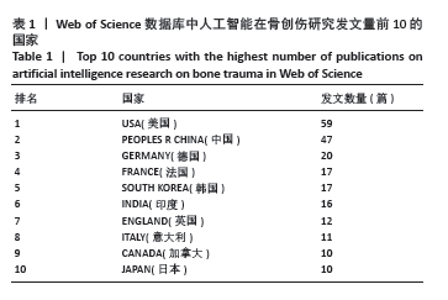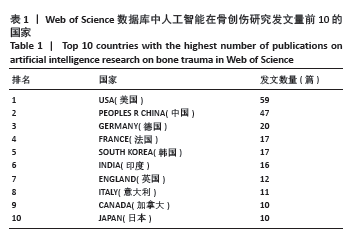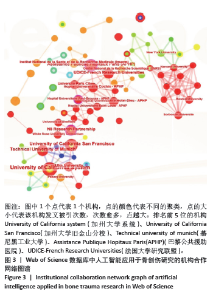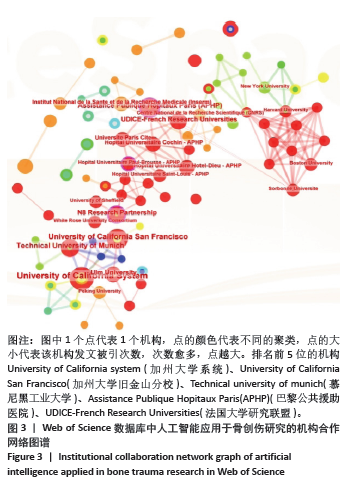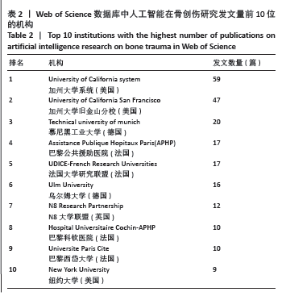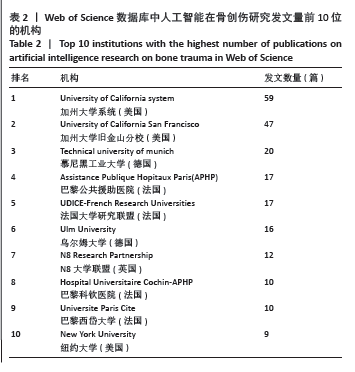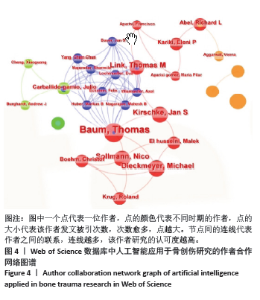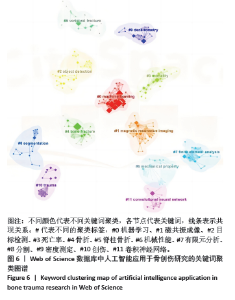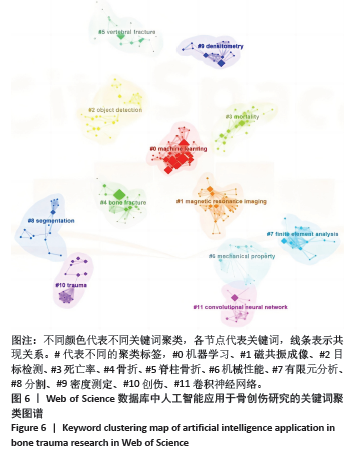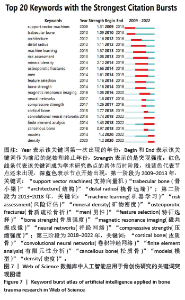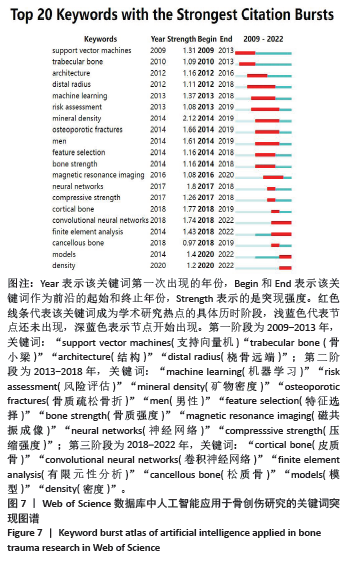Chinese Journal of Tissue Engineering Research ›› 2025, Vol. 29 ›› Issue (3): 493-502.doi: 10.12307/2025.129
Previous Articles Next Articles
Visualization analysis of artificial intelligence in bone trauma research based on Citespace
Song Haoran1, 2, Zhang Yuqiang1, 2, Gu Na3, Zhi Xiaodong1, 2, Wang Wei1, 2
- 1Department of Orthopedics, 3Department of Radiology, First Affiliated Hospital of Jinzhou Medical University, Jinzhou 121000, Liaoning Province, China; 2Institute of Osteology, Jinzhou Medical University, Jinzhou 121000, Liaoning Province, China
-
Received:2023-11-27Accepted:2024-01-05Online:2025-01-28Published:2024-06-03 -
Contact:Wang Wei, MD, Chief physician, Professor, Department of Orthopedics, First Affiliated Hospital of Jinzhou Medical University, Jinzhou 121000, Liaoning Province, China; Institute of Osteology, Jinzhou Medical University, Jinzhou 121000, Liaoning Province, China -
About author:Song Haoran, Master candidate, Department of Orthopedics, First Affiliated Hospital of Jinzhou Medical University, Jinzhou 121000, Liaoning Province, China; Institute of Osteology, Jinzhou Medical University, Jinzhou 121000, Liaoning Province, China -
Supported by:Jinzhou Medical University School-Enterprise Cooperation Fund Project, No. 2020002 (to WW); Innovation and Entrepreneurship Training Program for College Students at Jinzhou Medical University, No. X202210160044 (to ZYQ); Jinzhou Guiding Science and Technology Plan Project, No. JZ2023B090 (to ZYQ); Horizontal Project of Jinzhou Medical University, No. FSHX202403 (to WW)
CLC Number:
Cite this article
Song Haoran, Zhang Yuqiang, Gu Na, Zhi Xiaodong, Wang Wei. Visualization analysis of artificial intelligence in bone trauma research based on Citespace[J]. Chinese Journal of Tissue Engineering Research, 2025, 29(3): 493-502.
share this article
Add to citation manager EndNote|Reference Manager|ProCite|BibTeX|RefWorks
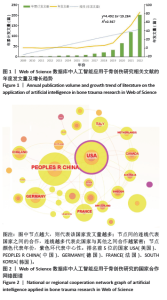
2.1 年度出版物的发展趋势 符合纳入标准的202篇文献中,包含189篇文章和13篇评论。因年度发表的研究数量反映文章领域的总体发展趋势,鉴于投稿时2023年的数据尚未完整,无法反映当年的整体出版情况,因此,此分析仅包括2009-2022年的文献。图1所示的年度发文量及增长趋势,表明自2009年起人工智能在骨科应用领域的研究发表量呈现逐年上升趋势,利用人工智能辅助骨创伤的诊断目前已成为研究热点,与2009-2019年发文相比,2020-2022年发文总量呈现爆发式增长。为进一步了解这一领域的年度出版趋势,通过绘制发文时期出版趋势线,获得指数函数Y=4.492 3X-19.264(R2=0.567,Y为年度出版物,X为年份),显然,人工智能在骨创伤中的应用具有巨大的潜力,相关研究将继续深入 研究。 2.2 国家和机构分布情况 文章使用Citespace对国家(或地区)和机构进行共引分析。国家或地区分布图由33个节点和52个链接组成。如图2和表1所示,发文量最多的国家是美国(59篇),其次是中国(47篇),是其他国家或地区的三四倍。排名前5位的国家是美国(59篇)、中国(47篇)、德国(20篇)、法国(17篇)、韩国(17篇)。对节点的分析表明,美国、德国和印度具有很高的中心性,它们与其他国家和中国的联系更多,韩国研究中心性为0,表明韩国进行独立研究,未与其他国家产生联系。"

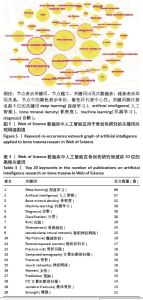
2.4 关键词、突发值、聚类和时间演变分析 文章的高频关键词可以帮助读者直观快速地了解该领域的主要研究热点。用Citespcace软件进行关键词共现分析。关键词共现网络共有265个节点和404个链接,见图5。表3列出了高频关键词。前20个关键词如下:深度学习、人工智能、骨密度、机器学习、诊断、分类、风险、骨质疏松、卷积神经网络、髋部骨折、绝经后妇女、骨折风险、计算机断层扫描、骨折、神经网络、女性、预测、CT、椎体骨折和增强。从这些关键词中,发现主要的研究方法是人工智能、深度学习和机器学习、神经网络和卷积神经网络;主要研究任务是诊断、分类和预测。主要研究内容为医学图像,主要研究对象为骨折、骨质疏松、髋部损伤及椎体骨折等。综上所述,利用人工智能技术通过医学图像对各种类型的骨折和进行分类、诊断和风险预测是目前的主要研究热点。 关键词聚类可以呈现相关研究领域的结构体系。图6显示了通过CitesSpace软件生成的12个不同的集群:#0机器学习、#1磁共振成像、#2目标检测、#3死亡率、#4骨折、#5脊柱骨折、#6机械性能、#7有限元分析、#8分割、#9密度测定、#10创伤、#11卷积神经网络,聚类的序数按聚类大小排列,序数越小,聚类越大[9]。人工智能应用于骨创伤研究的热点,根据关键词共现与聚类图谱分析结果归纳可知,人工智能在骨创伤领域的研究主要围绕人工智能算法技术以及识别骨创伤诊断展开。 关键词是对论文的核心概括,而强突发关键词是在一段时间内具有较高的突发值,通过对关键词进行突发性探测可以明确某一时间段内的研究重点与热点,从而判断研究的发展动向与前沿研究[21]。运用Citespace软件的“Burst”功能对关键词进行突发性探测得到20个突显词,见图7,主要分为3个阶段,其中第一阶段为2009-2013年,突发性关键词是支持向量机和骨小梁,说明人工智能计算机科学已经应用于骨科识别领域,支持向量机技术对骨小梁的识别进行初步探究。第二阶段为2013-2018年,突发性关键词是机器学习、骨质疏松、特征选择、骨强度、皮质骨和松质骨,机器学习最早应用在骨科方面是在识别预防骨质疏松。CABITZA等[22]对机器学习在骨科领域的应用进行系统梳理,总结机器学习在骨科领域的研究和应用情况,在骨科领域,机器学习技术已经被广泛应用于各种任务,包括疾病预测、诊断、手术规划和治疗。第3阶段为2018-2022年,突发性关键词是皮质骨及松质骨,通过特征性选择对皮质骨及松质骨进行识别,卷积神经网络、有限元分析和骨密度,由此说明当前人工智能选用深度学习卷积神经网络来构建模型,优化卷积神经网络性能和有限元性分析是当下研究的热点也是今后的研究趋势。"

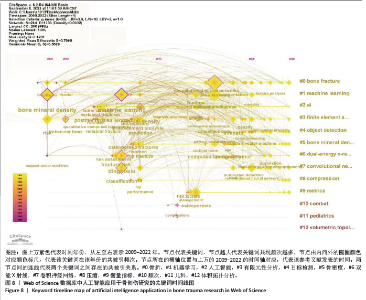
使用Citesapce绘制关键词的Timeline时间线图,这可能有助于从时间维度可视化阶段性热点和方向,见图8。通过Timeline可以直观地反映出研究领域的历史轨迹,揭示出各个研究方向之间的时间关系。人工智能应用于骨创伤领域的研究自2009开始,在支持向量机和机器学习的技术基础上,逐步对骨折、骨质疏松等的研究开始深入,医工结合研究热度一直持续至今。从图中不难发现,2015年前研究方向主要是机器学习检测骨质疏松和骨小梁的改变,2018年出现卷积神经网络,在机器学习的基础上继续优化,出现了深度学习概念,由于骨质疏松症通常发生在老年或绝经后女性,通常是因为骨折而被发现,因此筛查骨质疏松症可能有助于预防许多患者的骨质疏松性骨折,深度学习的出现有助于更加准确地预测骨质疏松症和可能的骨折风险。2022年人工智能在骨创伤领域出现研究高峰,图像分割、有限元性分析、卷积神经网络等关键词频繁出现。 2.5 被引文献分析 人工智能在骨创伤领域研究被引频次前10的文章见表4。共被引排名前10的参考文献分别从多个方面介绍了人工智能技术应用于骨创伤领域诊断的可行性的研究,其中8篇涉及骨关节损伤与深卷积神经网络,1篇涉及深度学习在CT检查中检测骨质疏松从而预防脆性骨折,1篇通过人工智能识别皮肤纹理变的特征应用于骨的特征性识别的相关性研究。 被引频次最高的文章(41次)是LINDSEY等[23]在2018年发表在《美国国家科学院院刊》的论文。骨折是常见的临床问题,但在诊断过程中存在一定的挑战,传统的骨折检测方法主要依赖于医生的经验和人工观察,这可能导致漏诊或误诊的情况,因此,研究人员尝试利用深度神经网络来改善骨折的检测和诊断。研究中使用了大量的骨折图像数据集来训练深度神经网络模型,经过训练,模型能够学习骨折的特征和模式,并能够准确地识别和定位骨折部位,研究结果表明,与传统的骨折检测方法相比,深度神经网络具有更高的准确性和敏感性。这项研究的结果对于改进骨折的诊断和治疗具有重要意义。通过使用深度神经网络,临床医生可以更准确地检测和诊断骨折,从而提高患者的治疗效果和康复速度,需要注意的是,该研究仍处于实验阶段,并需要进一步的验证和应用。然而,深度神经网络在医学图像诊断领域的潜力已经得到初步的证实,未来有望在临床实践中得到更广泛的应用,研究深度学习神经网络对骨折的检查的方法。 在2018年,KIM等[24]在《临床放射学》杂志上发表的论文,讨论在骨折检测中深度卷积神经网络的迁移学习方法的应用,研究中使用了一个大型的深度卷积神经网络模型作为基础模型,并通过迁移学习的方法将其应用于骨折检测任务,通过在大规模的骨折图像数据集上进行训练和微调,研究人员成功地将深度卷积神经网络应用于骨折的自动检测,与传统的骨折检测方法相比,该方法能够更快速、准确地识别和定位骨折。迁移学习技术在医学成像中具有许多潜在的应用价值,可以为人工智能模型的学习提供新方法。 在2018年,CHUNG等[25]在《Bone》上发表的文章具有最高的被引文献中心性(0.29),通过使用深度学习算法自动检测肩部正位平片和分类不同类型的近端肱骨骨折,研究结果表明,深度学习算法在近端肱骨骨折的检测和分类上具有较高的准确性和可靠性,这项研究的结果对于改进近端肱骨骨折的诊断和治疗具有重要意义。通过自动化的深度学习算法,医生可以更快速、准确地识别和分类近端肱骨骨折,从而为患者提供更好的治疗决策和个性化的护理。 在2017年,OLCZAK等[26]研究中利用了深度学习算法和卷积神经网络(CNN)来训练模型,以识别和分类不同类型的骨科创伤。深度学习算法通过学习大量的骨科创伤图像数据集,能够自动提取特征和模式,并进行准确的创伤诊断。研究结果表明,利用人工智能技术进行骨科创伤分析具有较高的准确性和可靠性。 在2018年,TOMITA等[27]使用了一个基于卷积神经网络(CNN)的深度神经网络模型来自动检测和诊断骨质疏松性椎体骨折,通过训练大规模的CT扫描图像数据集,来自动识别和定位骨质疏松性椎体骨折。深度神经网络通过学习大量的图像数据,能够自动提取骨质疏松性椎体骨折的特征和模式,并进行准确的检测和诊断。与传统的人工分析方法相比,深度神经网络能够更快速、准确地识别和定位骨质疏松性椎体骨折。 在2018年,URAKAWA等[28]介绍使用深度卷积神经网络进行图像识别,在检测转子间骨折方面具有高度的准确性,可以与专业的骨科医生相媲美。2019年,CHENG等[29]使用了一个深度学习算法,通过训练大量的普通盆腔X射线片和相应的骨折标记来建立模型,以检测和可视化髋部骨折;研究发现,它能够准确地检测到骨折的存在,这种深度学习算法在检测髋部骨折方面表现出了较高的准确性和灵敏度。 在2019年,PRANATA等[30]探讨在CT图像中使用深度学习和SURF算法进行跟骨骨折的自动分类和检测,研究目的是开发一种准确和高效的方法来帮助医生诊断和定位跟骨骨折。 在2018年,BADGELEY等[31]开发一种准确预测髋部骨折的算法,利用大量的医疗记录数据,包括患者的年龄、性别及身体质量指数等个人特征,以及医疗保健因素如住院时间、手术历史等,准确地预测髋部骨折的风险。 在2017年,ESTEVA等[32]研究使用了一个深度神经网络模型,通过分析皮肤病变图像中的特征,如颜色、纹理和形状,来进行分类,以帮助医生在早期诊断和治疗皮肤癌方面取得更好的结果。 2.6 文献热点小结 近20年来人工智能在骨创伤领域相关论文的发文量总体呈增长状态,发文量和中心性最高的国家为美国,这表明美国在全球人工智能应用于骨创伤领域的研究中处于核心地位;虽然中国发文量居第2位,但中心性低于其他国家,说明中国在该领域研究的影响力不足,与发达国家(美国和德国等)还存在一定的差距。然而,各国各机构之间的合作明显不足,国家之间、机构之间以内部合作为主,尚未形成大规模的合作。国家、机构和作者之间应建立更强大的合作网络,特别是加强国内外和医学科研工作者与计算机科学研究人员的相互合作,有助于研究人员充分发挥双方优势,共享资源和共同发展,这对人工智能应用于骨创伤方面研究的进一步发展至关重要。人工智能在骨创伤研究中最常用的前5个关键词是深度学习、人工智能、骨密度、机器学习和诊断。目前,该领域研究主要集中在人工智能应用于辅助识别诊断骨创伤性骨折,主要利用深度学习模型对骨折影像进行分类、分割和检测,辅助医生审查影像中是否存在异常,判断骨折的类型,定位骨折的位置,标注疑似骨折区域,骨创伤领域模型特征性识别机制、识别各种关节损伤以及预测骨损伤程度。前沿研究话题是:卷积神经网络、有限元分析和骨密度。今后,人工智能在医学有限元性分析建模[33]、多模态成像[34]、优化网络识别算法[35]、多部位目标检测[36]、多部位语义分割等方面的应用可能走在未来的前沿[37]。"
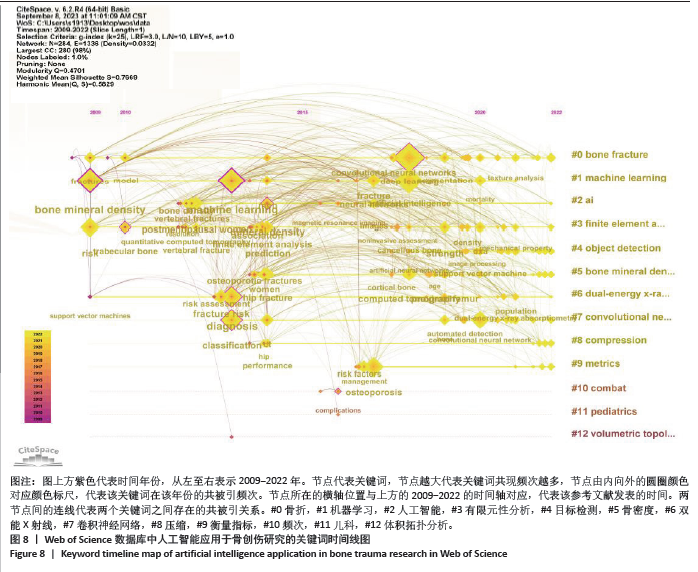
| [1] 薛冬,徐海林,王伟.人工智能辅助X射线识别对骨科的应用价值研究进展[J].中国骨伤,2020,33(9):887-890. [2] 张建,谢会群,提克扎提,等.人工智能在骨科影像学诊断中的应用研究进展[J].中国数字医学,2023,18(4):95-103. [3] SHAH AA, DEVANA SK, LEE C, et al. Development of a novel, potentially universal machine learning algorithm for prediction of complications after total hip arthroplasty. J Arthroplasty. 2020;36(5):1655-1662. [4] 翟禹樵,李开南.骨科人工智能诊断的研究进展[J].中国临床研究, 021,34(4):542-545. [5] LU Y, KHAZI ZM, AGARWALLA A, et al. Development of a machine learning algorithm to predict nonroutine discharge following unicompartmental knee arthroplasty. J Arthroplast. 2021;36(5): 1568-1576. [6] DANKELMAN LHM, SCHILSTRA S, IJPMA FFA, et al. Artificial intelligence fracture recognition on computed tomography: review of literature and recommendations. Eur J Trauma Emerg Surg. 2022;49(2):681-691. [7] KIJOWSKI R, LIU F, CALIVA F, et al. Deep learning for lesion detection, progression, and prediction of musculoskeletal disease. J Magn Reson Imaging. 2019;52(6):1607-1619. [8] KUO RYL, HARRISON C, CURRAN T, et al. Artificial intelligence in fracture detection: a systematic review and meta-analysis. J Radiology. 2022;304(1):211785-211785. [9] GUERMAZI A, TANNOURY C, KOMPEL AJ, et al. Improving radiographic fracture recognition performance and efficiency using artificial intelligence. J Radiology. 2021;302(3):210937-210937. [10] AlGHAITHI A, Al MASKARI S. Artificial intelligence application in bone fracture detection. J Musculoskelet Surg Res. 2021;5(1):4-9. [11] DEEPA J, THIPENDRA P, SINGH. A survey of fracture detection techniques in bone x-ray images. J Artif Intell Rev. 2020;(prepublish): 1-43. [12] 陈悦,陈超美,刘则渊,等.Citespace知识图谱的方法论功能[J].科学学研究,2015,33(2):242-253. [13] SYNNESTVEDT MB, CHEN C, HOLMES JH. Citespace ii: visualization and knowledge discovery in bibliographic databases. J AMIA Annu Symp Proc. 2005;2005:724-728. [14] CHEN CM, SONG M. Visualizing a field of research: a methodology of systematic scientometric reviews. PLoS One. 2019;14(10):0223994. [15] 任欢,曾奕玮,张粟,等.基于VOSviewer和Citespace分析功能性磁共振成像技术在针灸脑成像研究中的应用现状和趋势[J].世界科学技术-中医药现代化,2022,24(5):2114-2124. [16] 应倩,汪媛.医学类期刊H指数与影响因子、总被引频次的曲线拟合回归分析[J].中华医学图书情报志,2011,20(11):23-26. [17] 李科科,于文兵,李硕奇,等.基于Citespace软件的大学生社交焦虑研究的热点与前沿趋势分析[J].中国全科医学,2022,25(33): 4217-4226. [18] 陈冉,杨皓然,史会连,等.1991-2021年肝硬化营养研究热点及趋势可视化分析[J].中国全科医学,2022,25(32):4091-4098.
[19] 郝文雪,李瑞青,胡延超,等.2010-2019年卒中后认知障碍相关研究的可视化分析[J].中国全科医学,2021,24(6):759-776. |
| [1] | Li Jiagen, Chen Yueping, Huang Keqi, Chen Shangtong, Huang Chuanhong. The construction and validation of a prediction model based on multiple machine learning algorithms and the immunomodulatory analysis of rheumatoid arthritis from the perspective of mitophagy [J]. Chinese Journal of Tissue Engineering Research, 2025, 29(在线): 1-15. |
| [2] | Su Lintao, Jiang Jianfeng, Ma Jun, Huang Liangliang, Lei Changyu, Han Yaozheng, Kang Hui. Precise application of O-arm navigation system in thoracolumbar fractures with developmental pedicle stenosis [J]. Chinese Journal of Tissue Engineering Research, 2025, 29(9): 1855-1862. |
| [3] | Zhou Jiajun, Ma Fei, Leng Yebo, Xu Shicai, He Baoqiang, Li Yang, Liao Yehui, Tang Qiang, Tang Chao, Wang Qing, Zhong Dejun. Assessing distribution characteristics and clinical significance of vertebral fractures in patients with osteoporosis based on whole spine MRI [J]. Chinese Journal of Tissue Engineering Research, 2025, 29(9): 1883-1889. |
| [4] | Liang Haobo, Wang Zeyu, Ma Wenlong, Liu Hao, Liu Youwen. Hot issues in the field of joint revision: infection, rehabilitation nursing, bone defect, and prosthesis loosening [J]. Chinese Journal of Tissue Engineering Research, 2025, 29(9): 1963-1971. |
| [5] | Huang Haobo, Liang Xinyuan, Ye Guozhong, Xie Qingxiang, Su Boyuan. Suture tape and headless compression screws in treatment of Lisfranc injury with comminuted fractures of the first and second proximal metatarsal bones [J]. Chinese Journal of Tissue Engineering Research, 2025, 29(9): 1803-1809. |
| [6] | Lyu Liting, Yu Xia, Zhang Jinmei, Gao Qiaojing, Liu Renfan, Li Meng, Wang Lu. Bibliometric analysis of research process and current situation of brain aging and exosomes [J]. Chinese Journal of Tissue Engineering Research, 2025, 29(7): 1457-1465. |
| [7] | Wang Mi, Ma Shujie, Liu Yang, Qi Rui. Identification and validation of characterized gene NFE2L2 for ferroptosis in ischemic stroke [J]. Chinese Journal of Tissue Engineering Research, 2025, 29(7): 1466-1474. |
| [8] | Xie Liugang, Cui Shuke, Guo Nannan, Li Aoyu, Zhang Jingrui. Research hotspots and frontiers of stem cells for Alzheimer’s disease [J]. Chinese Journal of Tissue Engineering Research, 2025, 29(7): 1475-1485. |
| [9] | Chang Jinxia, Liu Yufei, Niu Shaohui, Wang Chang, Cao Jianchun. Visualization analysis of macrophage polarization in tissue repair process [J]. Chinese Journal of Tissue Engineering Research, 2025, 29(7): 1486-1496. |
| [10] |
Zhao Wensheng, Li Xiaolin, Peng Changhua, Deng Jia, Sheng Hao, Chen Hongwei, Zhang Chaoju, He Chuan.
Gut microbiota and osteoporotic fractures #br#
#br#
[J]. Chinese Journal of Tissue Engineering Research, 2025, 29(6): 1296-1304.
|
| [11] | Li Huijun, Li Huangyan, Zhang Yeting. Physical activity and cognition in older adults: research hotspot and topic evolution [J]. Chinese Journal of Tissue Engineering Research, 2025, 29(5): 1073-1080. |
| [12] | Liu Yani, Yang Jinghuan, Lu Huihui, Yi Yufang, Li Zhixiang, Ou Yangfu, Wu Jingli, Wei Bing . Screening of biomarkers for fibromyalgia syndrome and analysis of immune infiltration [J]. Chinese Journal of Tissue Engineering Research, 2025, 29(5): 1091-1100. |
| [13] | Dang Xiaowen, Huang Hailiang, Huang Lei, Wang Yajie . Research frontiers and hotspots of carbon nanomaterials in biomedical field over the past 10 years [J]. Chinese Journal of Tissue Engineering Research, 2025, 29(4): 752-760. |
| [14] | Yang Bin, Tao Guangyi, Yang Shun, Xu Junjie, Huang Junqing . Visualization analysis of research hotspots of artificial intelligence in field of spinal cord nerve injury and repair [J]. Chinese Journal of Tissue Engineering Research, 2025, 29(4): 761-770. |
| [15] | Yang Dingyan, Yu Zhenqiu, Yang Zhongyu. Machine learning-based analysis of neutrophil-associated potential biomarkers for acute myocardial infarction [J]. Chinese Journal of Tissue Engineering Research, 2025, 29(36): 7909-7920. |
| Viewed | ||||||
|
Full text |
|
|||||
|
Abstract |
|
|||||
